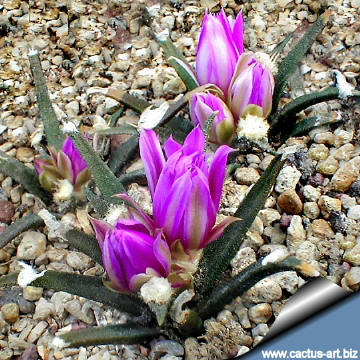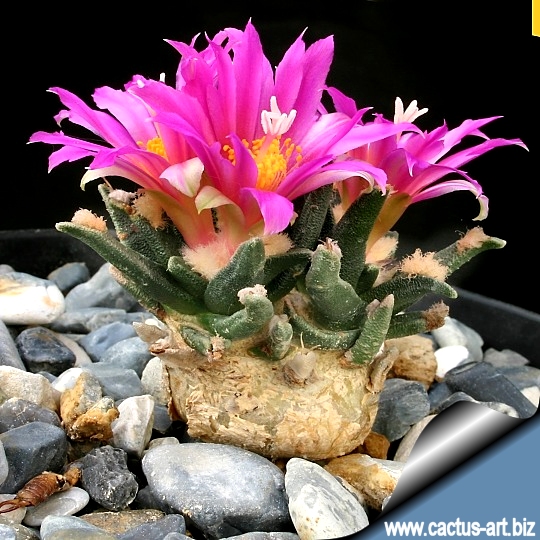|
|
|

Ariocarpus agavoides (SB 370 Tula, Tamahulipas mexico)
It looks very little like a cactus and more like a
Haworthia (or a small Agave, hence the name)
|
|

The flowers cover
the plant. |
Habit: Small
rosette shaped
succulent with stiff, rough, dark green
tubercles.
Stem: Greenish-brown
sub-globose, flattened on top, 2-6cm high, rising barely above
ground level, 4-8cm in diameter.The rest of the plant (swollen
rootstock) stay
underground.
Tubercles: Divergent, often flaccid and not
erect, not crowded or
basally compressed,
acute at the
apices, flattened
adaxially, not
fissured, not incurved, 3-7cm long, 5-10mm broad, more than 4 times
as long as wide;
Areoles: 5-12mm from the tips of the tubercles, rounded, 2-5 mm in
diam.;
Spines: None or rarely 2, 2-4mm long, whitish.
Flowers: 3.5-4.2cm in diam., 2-5cm long; outer
perianth segments magenta with greenish-white
margins, inner perianth parts deep magenta,
pistil 2-3mm above the
stamens;
style white. 1-2cm long;
stigmas 5-8, 1-2.5mm long;
Fruit: pinkish-red to reddish purple,
globose to
elongate, 10-20mm long, 5-12mm in diam.
|
 |

Flowers deep magenta in October |

A young seedling: the
rootstock |

This
species start flowering when still young. |
|
Photo
of conspecific taxa, varieties, forms and cultivars of Ariocarpus
agavoides:.
Advertising
|
|
|
|
|
|
|
Family:
Cactaceae (Cactus
Family)
Conservation status: Listed in
CITES appendix I
Scientific name:
Ariocarpus agavoides (Castenada) Anderson, (1962) Amer. J. Bot. 49: 615
Occasionally misspelled agavioides.
Original pubblication:
Neogomesia agavoides Castaneda, (1941) Cact.
Succ. Jour. 13: 98
Heterotypic synonyms:
Ariocarpus kotschoubeyanus ssp. agavoides
Origin: Mexico, The
type locality of A. agavoides is sited around the town of Tula, Tamaulipas. Two new
colonies have been found recently in San Luis Potosi, disjunct from
the original site (A. agavoides var. sanluisensis).
Habitat: Grows on rocky
limestone hills, and alluvial plains at about 1200 m,
rainy season is
summer. The
wild
populations have been
threatened and nearly
extinct by many factors including
over-collecting, agriculture, building work, livestock, and erosion.

|
|
|
|

A
Hypocotyl-graft
( a sophisticated
grafting technique that guarantee a fast
growth,
long-livedness and an easy cultivation, in addition hypocotyl-grafted
plants develop an attractive swollen
caudex-like
rootstock)
|
|
Cultivation: Grows in
alluvial plain that becomes muddy in
summer, so likes quite a lot of water then... but very
prone to rot other times of the year,
give moderate water in
spring and
autumn, no water in
winter. Cultivate it in a well drained, non-organic,
free-draining soil compost. The use of a weak low-nitrogen fertilizer
during the growing season can encourage growth. The main threat to
its development is root rot.
The Ariocarpus should be kept dry whenever there is a threat of
cold. The appearance of Ariocarpus can benefit greatly by watering
the plants from the bottom. This practice will help to keep the
“wool” on the top of the plant from becoming matted or discoloured.
Need
half shadel to
Full sunf. Frost Tolerance: Hardy to -10° C.
Propagation: It is easy to
raise from seed, but will generally take about 5-8 years to reach
flowering size, occasionally grafted. |
|

 |
|